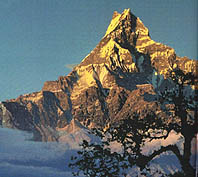Nowhere does the solitary splendour of the Himalayas
whisper to the traveller its most powerful message, than when it speaks
through the majesty of its Annapurna Range. One need not climb a mountain to
be dazzled by it.
 One
of the deepest valleys in the world, the Kali Gandaki forms the western
boundary of the sanctuary
One
of the deepest valleys in the world, the Kali Gandaki forms the western
boundary of the sanctuary
Rising abruptly from verdant forests of rhododendron,
bougainvillaea and bamboo, the Annapurna forms a magnificent arc of
snow-mantled peaks, five of which bear the name Annapurna. By tradition, the
Nepalese believe these mountains are the home of deities. For centuries both
Buddhist and Hindu devotees have made the pilgrimage to the sacred shrines at
Muktinath.
Today, pilgrims of a different kind are flocking to this
area for trekking adventures. A three to four week hike along the circuit
trail around the range, or an 8,500 foot climb up the Modi Khola Valley into
the Annapurna Sanctuary is a journey made in the shadow of the gods.
 Local
villagers are dedicated to protecting the fragile beauty of the park
Local
villagers are dedicated to protecting the fragile beauty of the park
Much more than a park, the thousand square mile Annapurna
Conversation Area Project was established in 1986, and incorporates
environmental management and the cooperation of the local inhabitants. The
creation of the park came none too soon, for the fragile beauty of the region
needed protection.
Sculptured fields of millet and corn cover the high slopes
above the Kali Gandaki Valley, which forms the western boundary of the park.
One of the deepest valleys on Earth, the Kali Gandaki lies between Dhaulagiri,
the world’s seventh highest mountain.
 Outdoor
latrines help curb trail waste but foul the local water
Outdoor
latrines help curb trail waste but foul the local water
With its grandstand view of the snow-capped Annapurna Range
to the north, and the subtropical Pokhara Valley to the south, the meadow
known as the Austrian Camp is a favorite stop for groups who are hiking the
200 mile trail through the conservation area.
Long closed to outsiders, the idea of introducing a
national park in this region was opposed by the native population for fear of
threat to their environment and Himalayan culture. There was a great deal at
stake. They had heard of whole villages being moved to make other Nepalese
parks wild enough to accommodate the trekkers’ expectations, and of families
that died of tropical diseases after forced relocation. The King Mahendra
Trust and the World Wildlife Fund set down a plan which makes the park and the
villagers self-supporting. Today villagers have learned to live with the
tourists and the trekkers, and relations between the locals and the visitors
are amicable. The park is now the most popular trekking area in Nepal.
 The
sacred summit of the Machapuchare is a Nepalese deity and off limits to
climbers
The
sacred summit of the Machapuchare is a Nepalese deity and off limits to
climbers
Here the awesome Himalayas pause and step back to expose an
amphitheatre three miles wide. Rising directly from its walls are nine peaks
over 21,000 feet high, each draped in a shattered cascade of glacial ice. Far
below the eternal snows, meadows and streams roll across the undulating floor
of the sanctuary. The trail is clean. The visitor is surrounded by beauty, not
trash. The master plan works because the local people make it work. And the
wildness of the surrounding landscape is in good hands.